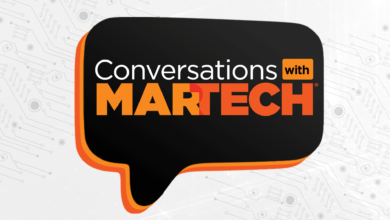10 martech predictions about what won’t happen in 2025

Every year, the world of martech is flooded with bold predictions about the future. But let’s be realistic: some of these predictions will never come true. Here are 10 martech trends you won’t see in 2025, and why they’re just not realistic.
1. Martech is getting cheaper
In most areas of technology, devices are getting smaller and cheaper every day, but martech software is becoming more and more bulky and expensive. This is not going to change. We’re all going to be spending more on martech tools this year – and probably in the years to come. For what?
Part of the problem is that established martech tool providers tend to dominate, making it difficult and expensive for startups to disrupt existing martech categories. As a result, startups often compete in new martech categories that they help create. Ultimately, these categories are integrated into established tools, making everything more complex and more expensive.
2. Martech Stacks Are Getting Smaller
The implacable increase in complexity alone will guarantee that this will never happen!
3. AI Writes Long, Impeccable Marketing Copy
The AI is pretty cool. It’s exciting to see what a computer can create. What’s not so exciting – and extremely frustrating – is that the AI simply isn’t good enough. Whether it’s creating lies by misusing technical language or spewing out bland, formulaic copy, AI still needs an editor with a flesh-and-blood brain to ensure the real world context.
And what happened to the massive AI improvements we were promised for 2024? Has AI already reached its capacity ceiling?
Dig Deeper: What every marketer should pay attention to in 2025
4. Automatic campaign optimization will work perfectly every time
We all love the “super auto” mode of marketing platforms. From advertising to marketing automation, the promise of set it and forget it seems incredible. (Just imagine creating a campaign and letting the platform optimize it for you!)
Unfortunately, this is often not the case. Yes, you can get some modest improvements, especially with simple tasks like A/B testing. But the platform can’t go beyond telling you whether A or B performed better. You still need a human to determine why one ad outperformed another, then create option C to outperform A and B. In short, automatic campaign optimization is still not optimal.
5. We solve the problem of attribution and ROI
No. Sorry. We are still a long way from being able to directly attribute results to multi-channel campaigns or determine the exact ROI of a particular activity.
For what? The reasons are multiple:
Long sales cycles. The time it takes to build a brand. The interaction of different tactics, making it impossible to isolate the effectiveness of any one of them. The challenge of collecting relevant data in a B2B context where sales are made by people.
The problems far outweigh the solutions. Even though we’re making progress on some channels (e.g., e-commerce search ads), if you’re in a field like public relations, you probably won’t be able to realistically measure ROI until many years.
Dig Deeper: The marketing ROI problem has its roots in marketing culture
6. Blockchain is revolutionizing marketing
There was a lot of initial hype around the use of blockchain in marketing, but that has died down – and is unlikely to return. The touted benefits don’t outweigh the complexity of moving to a new way of tracking marketing performance. However, if Bitcoin continues to grow, we might be tempted to try crypto. I’m just saying.
7. Cookies eventually die
Despite countless assassination attempts, the omnipresent cookie remains stubbornly alive. And it will live well beyond 2025.
We may be seeing the final years of the third-party cookie, but even that cookie won’t completely collapse in 2025. First-party cookies, on the other hand, are becoming increasingly important and will thrive in 2025.
Dig Deeper: What’s next for Google’s third-party cookie saga?
8. Customers will finally get paid for sharing their data
Sorry to disappoint you, but I repeat: this simply won’t work. The process would be so cumbersome that consumers would not justify the time and effort required, especially since the real value of an individual’s data is too low.
The only viable model would involve a few companies controlling the market. The data privacy implications of such dominant players are simply too frightening to consider.
9. QR codes replace URLs
With all the recent stories about computer security risks related to QR codes, the public is becoming increasingly wary of scanning these scrambled squares.
Ironically, this ad encourages more people to misuse QR codes for hacking or other shady activities. No, we won’t be saying goodbye to URLs anytime soon. Keep creating those memorable vanity URLs!
10. Chatbots now understand sarcasm
When chatbots work, they’re great. But they still have limits. As English people, their lack of understanding of sarcasm is particularly annoying.
For example, when they give you the wrong answer and you respond, “Oh, thanks. This was so helpful,” chatbots will always respond, “I’m glad I could help.” Would you like to rate my support five stars?
Um, can I get back to you on that?
Dig Deeper: Why AI will have the flaws of human intelligence
Contributing authors are invited to create content for MarTech and are chosen for their expertise and contribution to the martech community. Our contributors work under the supervision of the writing and contributions are checked for quality and relevance to our readers. The opinions they express are their own.



